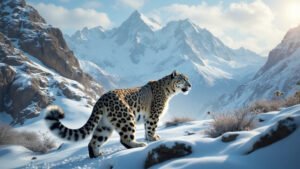Introduction
Mountain ranges are crucial in determining where snow leopards, one of the world’s most elusive big cats, can thrive. These rugged, often inaccessible landscapes provide a unique habitat that supports the snow leopards’ physical and behavioral adaptations
In this article, we will explore how elevation, prey availability, and climate play a role in snow leopard distribution, the significance of specific mountain ranges, and the challenges posed by human activity
Furthermore, we’ll delve into the adaptations that enable snow leopards to survive in harsh mountainous environments and examine the impact of climate change on their future survival
How Mountain Ranges Shape Snow Leopard Habitats
Mountain ranges provide the primary habitat for snow leopards, shaping their distribution in significant ways. Found across Central and South Asia, snow leopards inhabit regions such as the Himalayas, the Karakoram, the Tien Shan, and the Altai mountains
These rugged environments offer isolation from human activity, making them ideal for snow leopards to hunt, rest, and raise their young. But more than just providing shelter, mountain ranges influence crucial ecological factors such as elevation, prey availability, and terrain, all of which affect where snow leopards can survive and thrive
The Role of Elevation in Snow Leopard Distribution
Elevation is one of the most important factors in the distribution of snow leopards. They are typically found at altitudes ranging from 9,800 to 16,500 feet (3,000 to 5,000 meters) above sea level
This elevation range provides an environment with fewer human settlements and more prey, such as blue sheep, ibex, and other mountain ungulates. A study by McCarthy et al. (2017) highlights that snow leopards prefer elevations that offer rocky outcrops and steep terrain, which facilitate stalking prey and provide cover from predators or humans
The steep, often inaccessible slopes of mountain ranges help snow leopards avoid threats from poaching and human-wildlife conflict. However, this also limits their range, as their distribution is closely tied to areas that provide both elevation and the right kind of rocky habitat
In regions where mountains have been fragmented or where human development has encroached into higher altitudes, snow leopard populations have been forced into more isolated pockets, reducing their overall distribution
Rocky Terrain and Camouflage for Snow Leopards
The rugged, rocky terrain typical of mountain ranges plays a crucial role in snow leopard survival. Their pale, spotted coats are a perfect camouflage against the rocky, snowy backdrop of their habitats, allowing them to stalk prey undetected
This rocky environment is essential not only for hunting but also for protection from larger predators and human threats. A study conducted by Kachel et al. (2017) indicates that snow leopards are more likely to be found in areas with complex terrain, as it provides them with the cover they need to ambush their prey
The physical structure of mountain ranges — cliffs, boulders, and steep slopes — offers an ideal environment for snow leopards to exploit their agility and stealth. These predators can traverse difficult landscapes that most other predators would find impossible, giving them an advantage in hunting and survival
However, this reliance on specific rocky habitats means that changes in terrain, whether through natural erosion or human interference, can directly impact their ability to hunt and thrive
Prey Availability in Mountainous Regions
Prey availability is another critical factor that determines where snow leopards can be found. In mountainous regions, their primary prey includes blue sheep (bharal), ibex, marmots, and other mountain species
The abundance of these species in a particular mountain range directly affects snow leopard distribution. According to Johansson et al. (2016), snow leopards can cover vast areas—up to 77 square miles (200 km²)—in search of prey, but they are more densely concentrated in regions where prey is more abundant
Mountain ranges that support healthy populations of prey species are essential for the survival of snow leopards. In contrast, regions where prey populations have declined due to overhunting by humans or habitat destruction can see a corresponding decrease in snow leopard numbers
Conservation efforts often focus on protecting these prey species, as their availability is directly linked to the health of snow leopard populations
Climate and Snow Leopard Survival in Mountain Ranges
The extreme climates found in mountain ranges are another significant factor that shapes the distribution and survival of snow leopards
These big cats are well adapted to the cold, harsh environments of high-altitude regions, where temperatures can plummet below freezing, and snow can cover the landscape for several months each year
However, the variability of climate within mountain ranges, along with broader climate change, poses challenges for snow leopards as they struggle to find stable habitats and sufficient prey
Harsh Mountain Climates and Snow Leopard Adaptations
Snow leopards are superbly adapted to withstand the often brutal climates of their mountain habitats. Their thick fur, which is nearly 2 inches (5 cm) long in some areas, insulates them from the cold, while their large, furry paws act as snowshoes, allowing them to walk across snow without sinking
Their long, bushy tails serve multiple purposes: they help with balance on steep, rocky slopes, and when curled around the body, they provide additional warmth during cold nights
Despite these adaptations, extreme cold and heavy snowfall can still present challenges. Snow leopards must expend more energy to hunt in deep snow, and prey becomes scarcer during particularly harsh winters
A study published by Sharma et al. (2014) found that in years with severe winters, snow leopards often shift to lower elevations where conditions are less extreme, although this move can bring them into closer contact with human settlements, increasing the risk of conflict
Seasonal Variations in Mountainous Environments
The seasonality of mountain climates also affects snow leopard behavior and distribution. In summer, when snow recedes to higher elevations, snow leopards tend to follow their prey up the mountains, as animals like blue sheep and ibex migrate to higher pastures
This seasonal migration allows snow leopards to access prey more easily during the warmer months, when food is more abundant
However, during winter, when deep snow covers much of the higher altitudes, snow leopards are forced to descend to lower elevations. This seasonal movement is critical for their survival but also exposes them to greater dangers from humans. In many regions, snow leopards are more likely to prey on livestock during the winter months when wild prey is less accessible
This behavior can lead to retaliatory killings by local herders, further threatening snow leopard populations, as noted by McCarthy et al. (2017)
How Climate Change Affects Mountain Ranges
Climate change presents a growing threat to snow leopard habitats. As temperatures rise, the delicate balance of these mountain ecosystems is disrupted
Snow patterns are shifting, with less snowfall and earlier melts, which in turn affects the availability of water and plant growth, impacting the entire food chain. Snow leopards rely on a stable, cold environment not only for hunting but also for breeding, as their thick coats and energy-intensive hunting methods are adapted to cold conditions
A study by Li et al. (2019) shows that as temperatures increase, snow leopards may be forced to move to higher elevations to find suitable habitats, but the available range at such altitudes is limited. This phenomenon, known as “the mountain squeeze,” means that snow leopards may run out of viable habitats as warming continues
Additionally, changes in temperature and precipitation patterns can lead to a decline in prey populations, making it harder for snow leopards to find sufficient food
The Importance of Specific Mountain Ranges to Snow Leopards
Certain mountain ranges play a pivotal role in sustaining snow leopard populations due to their unique ecological characteristics, geographical isolation, and suitability for providing critical habitat needs
Across Central and South Asia, some of the most significant ranges include the Himalayas, the Altai Mountains, and the Tien Shan, each supporting key populations of this elusive predator. Understanding how snow leopards rely on these specific regions is essential for targeted conservation efforts
Key Mountain Ranges for Snow Leopard Populations
The snow leopard’s range spans several major mountain systems, but a few stand out due to their ecological importance. The Himalayas, which stretch across five countries—India, Nepal, Bhutan, China, and Pakistan—host a significant portion of the global snow leopard population
The rugged, remote terrain of these mountains offers the isolation and prey density that snow leopards require. McCarthy et al. (2017) emphasize that the Himalayas serve as a stronghold for the species, with relatively intact habitats compared to other regions
The Altai Mountains, which traverse Russia, Mongolia, China, and Kazakhstan, are another vital habitat. Snow leopards in the Altai are adapted to harsher, drier conditions and rely heavily on ibex and argali sheep for sustenance
Conservation studies highlight the need to protect these transboundary regions, where international cooperation is crucial for maintaining habitat corridors that allow snow leopards to move freely across borders
The Tien Shan range, located primarily in Kyrgyzstan, Kazakhstan, and China, is notable for its extensive snow leopard populations as well. A study by Kachel et al. (2017) highlights that the Tien Shan’s relatively stable prey base and secluded mountainous terrain make it an essential area for snow leopard conservation efforts
Territory and Range Size in Different Mountain Regions
Snow leopard territories can vary greatly depending on the availability of prey, the density of the population, and the geographical characteristics of the region
In more prey-abundant regions, such as parts of the Himalayas, snow leopard territories can be relatively small, with males covering around 12 to 39 square miles (30 to 100 square kilometers). In contrast, in prey-scarce regions like the Altai or Tien Shan, territories can span up to 193 square miles (500 square kilometers) or more
This variation in territory size has significant implications for conservation. In areas where snow leopards require larger ranges, habitat fragmentation poses a critical threat
Roads, mining, and human settlements in these regions can cut off access to parts of their territory, reducing hunting opportunities and increasing the likelihood of human-wildlife conflict
The size of their range also means that effective conservation requires large, contiguous areas of protected habitat to support viable populations
Barriers Created by Mountain Ranges
While mountain ranges serve as protective environments for snow leopards, they can also act as barriers, limiting the movement of individuals between populations
This isolation can lead to genetic bottlenecks, reducing the genetic diversity needed for long-term survival. The fragmented nature of mountain habitats, compounded by human development, means that some snow leopard populations are becoming increasingly isolated from one another
Studies like that of Li et al. (2019) have shown that these natural barriers are compounded by man-made obstacles, such as roads and infrastructure projects in mountain regions
For instance, road development in the Himalayas and the Karakoram is creating physical barriers that disrupt traditional snow leopard migration routes. These blockages prevent the natural mixing of populations, which is essential for maintaining genetic health and preventing inbreeding
To address this issue, conservationists are focusing on creating wildlife corridors that allow snow leopards to move between isolated habitats. International cooperation is also crucial, as snow leopards frequently roam across borders, and conservation efforts need to be coordinated across multiple countries
Protecting these corridors will help ensure the long-term survival of snow leopards in fragmented mountain environments
Human Impact on Snow Leopard Distribution in Mountain Ranges
Human activities in and around mountain ranges have a significant effect on snow leopard habitats and their distribution. These impacts range from habitat destruction and fragmentation to direct conflicts with humans over livestock predation
As human populations grow and expand into previously undisturbed areas, snow leopards face increasing threats to their survival. Conservation efforts must address these issues to ensure the protection of snow leopard populations
Deforestation and Habitat Fragmentation
One of the most pressing threats to snow leopards is habitat fragmentation due to deforestation and land-use changes
In many parts of their range, particularly in the Himalayas and Central Asian mountain ranges, forests and grasslands are being cleared for agriculture, infrastructure development, and mining. This reduces the available habitat for snow leopards and the prey species they rely on
According to Sharma et al. (2014), mining activities, particularly in regions like the Altai and Tien Shan, have disrupted snow leopard habitats, causing them to abandon previously suitable areas. Roads built for mining and transportation fragment these habitats further, cutting off snow leopard migration routes and isolating populations
This habitat fragmentation not only reduces the area where snow leopards can hunt and breed but also increases the likelihood of human-wildlife conflict as snow leopards are forced into closer proximity to human settlements
Human-Wildlife Conflict in Mountain Habitats
Human-wildlife conflict is a major issue in areas where snow leopards and local communities coexist. In many mountain regions, especially in the Himalayas and Central Asia, livestock farming is a critical livelihood
Snow leopards, facing reduced numbers of wild prey due to habitat degradation, may turn to livestock as an alternative food source. This can lead to significant economic losses for herders, who may retaliate by killing snow leopards
A study by McCarthy et al. (2017) indicates that livestock predation is one of the leading causes of snow leopard mortality, with herders in some regions poisoning or shooting snow leopards in response to attacks on their animals
To mitigate this issue, conservation programs have introduced livestock insurance schemes and predator-proof corrals to help reduce losses and improve coexistence between snow leopards and local communities
Additionally, education programs aimed at raising awareness about the importance of snow leopards in the ecosystem have been implemented in many mountain regions. By helping local communities understand the ecological role of snow leopards, these programs aim to reduce retaliatory killings and promote a more harmonious relationship between humans and wildlife
Conservation Efforts to Protect Snow Leopards
To address the impact of human activities on snow leopard distribution, numerous conservation initiatives have been launched across their range. These efforts focus on habitat protection, conflict mitigation, and international cooperation
One such initiative is the Global Snow Leopard and Ecosystem Protection Program (GSLEP), which brings together 12 countries that share snow leopard habitats. The GSLEP aims to secure at least 20 snow leopard landscapes across these countries by 2020 through collaborative conservation efforts
Protected areas, such as national parks and wildlife reserves, are also crucial for safeguarding snow leopard habitats. In regions like India and Nepal, the establishment of protected areas in the Himalayas has helped create safe zones for snow leopards and their prey
These protected areas are vital for maintaining snow leopard populations, as they provide large, contiguous habitats that are less affected by human activities
Furthermore, wildlife corridors are being developed to allow snow leopards to move between fragmented habitats. These corridors help maintain genetic diversity by enabling individuals from different populations to interbreed. International cooperation is essential for these efforts, as snow leopards often cross national borders in search of prey and mates
Countries like China, Mongolia, and Russia have been working together to establish transboundary protected areas that facilitate snow leopard movement across political boundaries
Adaptations That Help Snow Leopards Thrive in Mountainous Terrain
Snow leopards are uniquely equipped to survive in some of the harshest environments on Earth. Living in the rugged mountain ranges of Central and South Asia, they face extreme cold, steep terrain, and scarcity of prey
Over time, snow leopards have evolved remarkable physical and behavioral adaptations that allow them to thrive in these challenging habitats. These adaptations enable them to navigate their environment, hunt effectively, and conserve energy during periods of scarcity
Physical Adaptations for Steep Terrain
One of the most notable physical features of snow leopards is their powerful hind legs, which are longer than their front legs. This adaptation allows them to leap up to 30 feet (9 meters) in a single bound, which is essential for navigating the steep, rocky terrain of their mountainous habitat
Their large, muscular bodies are built for climbing and jumping across rocky cliffs, giving them an advantage when pursuing prey such as ibex or blue sheep that also live in high-altitude environments
Snow leopards’ paws are another key adaptation. Their large, fur-covered paws act like natural snowshoes, distributing their weight evenly over soft snow and allowing them to move easily across snowy landscapes
The fur on their paws also provides additional insulation against the cold, helping to keep them warm during the freezing winter months common in mountain ranges
Their tails are incredibly long—sometimes as long as their bodies—and serve multiple purposes. Primarily, the tail helps with balance when navigating the uneven, rocky terrain
In addition, snow leopards use their thick, furry tails as a blanket, wrapping them around their bodies for warmth while they rest in cold conditions
Behavioral Adaptations for Harsh Conditions
Snow leopards have developed several behavioral strategies to cope with the extreme conditions of their environment. One of the most important adaptations is their solitary nature
Snow leopards are highly territorial and prefer to roam large areas, sometimes covering up to 77 square miles (200 square kilometers), depending on the availability of prey. This solitary lifestyle reduces competition for limited food resources and allows them to cover vast areas in search of prey
Another behavioral adaptation is their ability to conserve energy during periods of prey scarcity. Snow leopards can survive on a single large meal for several days, and they are highly efficient hunters
They often stalk their prey for hours, using the mountainous terrain for cover before launching a surprise attack. When food is scarce, they can slow their metabolic rate to conserve energy, a vital survival strategy in environments where prey is not always abundant
Additionally, snow leopards are crepuscular, meaning they are most active during dawn and dusk. This behavior helps them avoid the heat of the day in warmer months and reduces their chances of encountering humans or other potential threats
Survival Strategies in Isolated Mountain Areas
The isolation of snow leopard habitats plays a key role in their survival. Unlike many other big cats, snow leopards have evolved to live in remote, high-altitude regions where few other large predators can survive
This isolation from competitors such as tigers or wolves allows them to occupy a unique ecological niche, where they are the top predator in their environment
In addition to their physical and behavioral adaptations, snow leopards have evolved a remarkable ability to blend into their surroundings. Their pale, smoky-gray fur, covered with dark rosettes and spots, provides excellent camouflage against the rocky and snowy terrain
This camouflage is critical not only for hunting but also for avoiding detection by humans, who pose one of the greatest threats to snow leopard survival
In recent years, as human activities have increasingly encroached upon snow leopard habitats, these adaptations have been put to the test. Snow leopards are now required to navigate human-made obstacles such as roads, livestock farms, and settlements
However, their agility, stealth, and resilience continue to help them survive in some of the most isolated and inhospitable regions on Earth
Conclusion
Mountain ranges play an essential role in the distribution and survival of snow leopards by providing the challenging, isolated environments they need to thrive. Elevation, rugged terrain, and the availability of prey are key factors that determine where snow leopards can live
These big cats are perfectly adapted to their mountainous habitats, with specialized physical traits such as powerful hind legs and large, fur-covered paws that allow them to navigate steep, rocky slopes and survive in extreme cold. Climate also plays a critical role in their distribution, with harsh winters and shifting seasonal patterns influencing their movement and survival strategies
However, human activities, including habitat fragmentation, deforestation, and conflict over livestock predation, pose significant threats to snow leopard populations. Conservation efforts, such as creating wildlife corridors, protecting key habitats, and reducing human-wildlife conflict, are vital to ensuring their survival
As climate change continues to alter mountain ecosystems, protecting these majestic animals and the mountain ranges they call home will require ongoing international cooperation and targeted conservation initiatives












